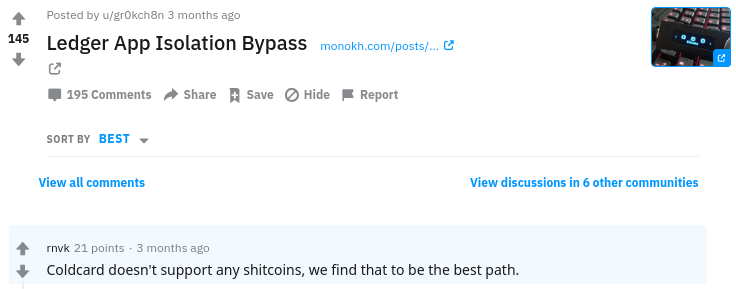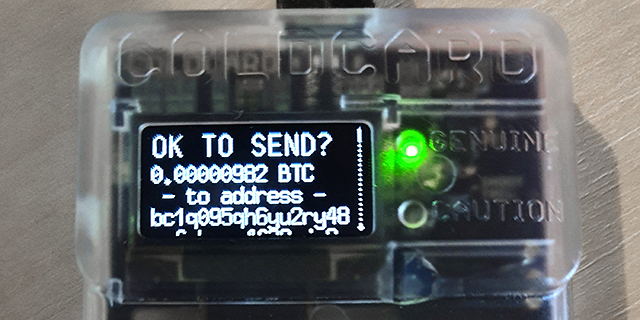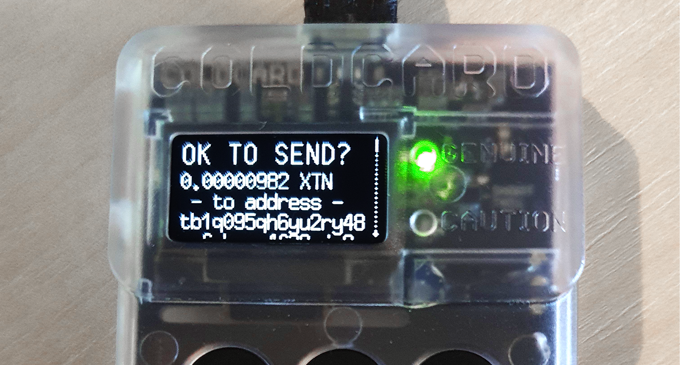Coldcard isolation bypass
Shift Crypto responsibly disclosed the remote exploit to Coinkite (Coldcard) on August 4th, 2020, and mutually agreed to a 90-day disclosure embargo period. Coinkite created a fix on September 30th but, as of this date, have not yet released a firmware update to mitigate against potential exploits in the wild. The fix on September 30th explicitly described the issue and attack scenarios in the changelog, and the 90-day embargo period, including requested extensions, has lapsed. Therefore, we now disclose the issue, and we encourage Coldcard users to take appropriate precautions until an update is available.
The original issue
On August 4th 2020, @mo_nokh disclosed a vulnerability in the Ledger hardware wallets in which a user could unknowingly confirm a Bitcoin transaction that was masquerading as an altcoin or testnet transaction.
An attacker can exploit this method to transfer Bitcoin while the user is under the impression that a transaction of another, less valuable altcoin (e.g. Litecoin, Testnet Bitcoins, Bitcoin Cash, etc.) is being executed
A quick high-level summary of how this is possible:
When you create a transaction proposal on your computer, the transaction is sent to the hardware wallet to be confirmed by the user and formally signed. The computer also tells the hardware wallet what kind of coin we are dealing with, e.g. “this is a Litecoin transaction, please show the amounts as Litecoin and display the addresses in Litecoin’s address formats”. The hardware wallet will just take that info, and show, for example “Sending 1 LTC to ltc1…”.
Litecoin, Bitcoin, their testnets and some other coins all have the exact same transaction representation under the hood. For example, there is nothing in a Bitcoin transaction that says it is a Bitcoin transaction and not a Litecoin transaction. From a hardware wallet’s point of view, a valid Litecoin transaction proposal is also a valid Bitcoin transaction proposal.
As a consequence, a compromised wallet on the computer can simply create a transaction spending bitcoins to the attacker, and send it to the hardware wallet as a Litecoin transaction. The user will only see Litecoin information on the device (addresses in Litecoin’s address format, amounts denominated in Litecoin, etc) while not suspecting that they are in fact sending bitcoins.
The problem is mitigated by allocating separate private keys to separate coins, as described by BIP44. If all your bitcoins use one set of private keys, and all your litecoins use a different set of private keys, then signing a Litecoin transaction with Litecoin keys can never spend actual bitcoins. The BitBox02 has always enforced this key separation strictly.
Coldcard
When the isolation bypass vulnerability was disclosed, Coldcard responded quickly that they were not affected:

This, unfortunately, was not true. While the Coldcard does not support “shitcoins”, it does support testnet. A quick test confirmed that the Coldcard was in fact vulnerable in the exact same way as Ledger. A user confirming a testnet transaction on the device could be spending mainnet (i.e. the real thing) funds without their knowledge.
For example, this real mainnet transaction:

…is confirmed and signed like this when sending the same real mainnet transaction to the Coldcard while it is in testnet mode:

Impact and severity
As a hardware wallet user, you should assume your computer is compromised. That is the reason to use a hardware wallet in the first place. Starting from there, exploiting this attack is not very far fetched. The attacker merely has to convince the user to e.g. “try a testnet transaction”, or to buy an ICO with testnet coins (I’ve heard there was a ICO like this recently) or any number of social engineering attacks to make the user perform a testnet transaction. After the user confirms a testnet transaction, the attacker receives mainnet bitcoin in the same amount.
Since the attack can be performed remotely, it counts as a critical issue according to Shift’s security assessment guideline. Severity points are deducted as the attack does not scale very well:
- the device has to be unlocked and user interaction is required
- the attacker has to convince the user to make a testnet transaction to the attacker’s testnet address
Credit
I did not discover the isolation bypass attack, all credit goes to @mo_nokh, who published the original attack on the Ledger. After reading about it, I remembered that the Coldcard has testnet support. I quickly built a proof-of-concept to see if this attack is feasible. Seeing that it indeed is, I immediately responsibly disclosed the issue to the Coldcard team.
Disclosure timeline:
- The issue was responsibly disclosed to Coinkite on Aug. 4th, 2020.
- Coinkite acknowledged the issue on Aug. 5th and asked for 90 days to fix the issue.
- Coinkite created a fix on Sept. 30th, publicly disclosing the issue and attack scenario in the changelog: https://github.com/Coldcard/firmware/pull/49/files
- Noticing the fix, on Oct. 14th we asked when to expect a firmware release. Coinkite informed that additional items are being added in advance of the next firmware release.
- On Nov 12th, one week beyond the embargo period, we asked again when to expect a firmware release and gave notice that we would release our disclosure soon. Coinkite informed that the release would be further delayed, but imminent, as additional items were being included.
- On Nov 21st, we informed Coinkite that we would publish our disclosure on Nov 24th.
- On Nov 23rd, Coldcard published a BETA version of the next firmware with the fix inlucded: https://github.com/Coldcard/firmware/tree/master/releases